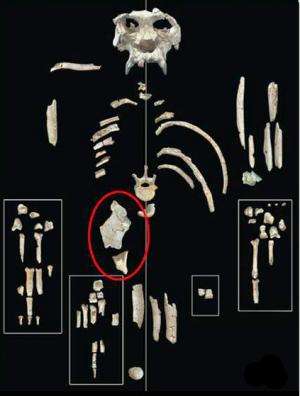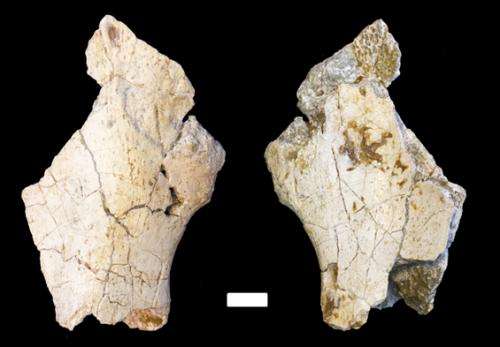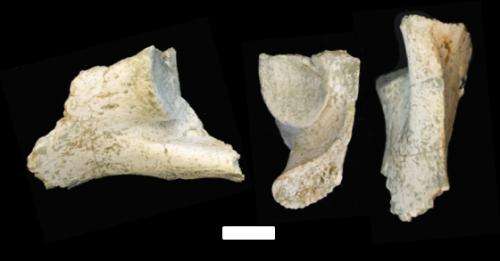11.9 million-year-old fossil of great ape sheds light on evolution

(Phys.org) —Researchers who unearthed the fossil specimen of an ape skeleton in Spain in 2002 assigned it a new genus and species, Pierolapithecus catalaunicus. They estimated that the ape lived about 11.9 million years ago, arguing that it could be the last common ancestor of modern great apes: chimpanzees, orangutans, bonobos, gorillas and humans. Now, a University of Missouri integrative anatomy expert says the shape of the specimen's pelvis indicates that it lived near the beginning of the great ape evolution, after the lesser apes had started to develop separately but before the great ape species began to diversify.
Ashley Hammond, a Life Sciences Fellow in the MU Department of Pathology and Anatomical Sciences, is the first to examine the pelvis fragments of the early hominid. She used a tabletop laser scanner attached to a turntable to capture detailed surface images of the fossil, which provided her with a 3-D model to compare the Pierolapithecus pelvis anatomy to living species.

Hammond says the ilium, the largest bone in the pelvis, of the Pierolapithecus catalaunicus is wider than that of Proconsul nyanzae, a more primitive ape that lived approximately 18 million years ago. The wider pelvis may be related to the ape's greater lateral balance and stability while moving using its forelimbs. However, the fingers of the Pierolapithecus catalaunicus are unlike those of modern great apes, indicating that great apes may have evolved differently than scientists originally hypothesized.
"Pierolapithecus catalaunicus seemed to use a lot of upright behaviors such as vertical climbing, but not the fully suspensory behaviors we see in great apes alive today," Hammond said. "Today, chimpanzees, orangutans, bonobos and gorillas use forelimb-dominated behaviors to swing below branches, but Pierolapithecus catalaunicus didn't have the long, curved finger bones needed for suspension, so those behaviors evolved more recently."

Hammond suggests researchers continue searching for fossils to further explain the evolution of the great apes in Africa.
"Contrary to popular belief, we're not looking for a missing link," Hammond said. "We have different pieces of the evolutionary puzzle and big gaps between points in time and fossil species. We need to continue fieldwork to identify more fossils and determine how the species are related and how they lived. Ultimately, everything is connected."
The study, "Middle Miocene Pierolapithecus provides a first glimpse into early hominid pelvic morphology," will be published in an upcoming issue of the Journal of Human Evolution.
Journal information: Journal of Human Evolution
Provided by University of Missouri-Columbia


















